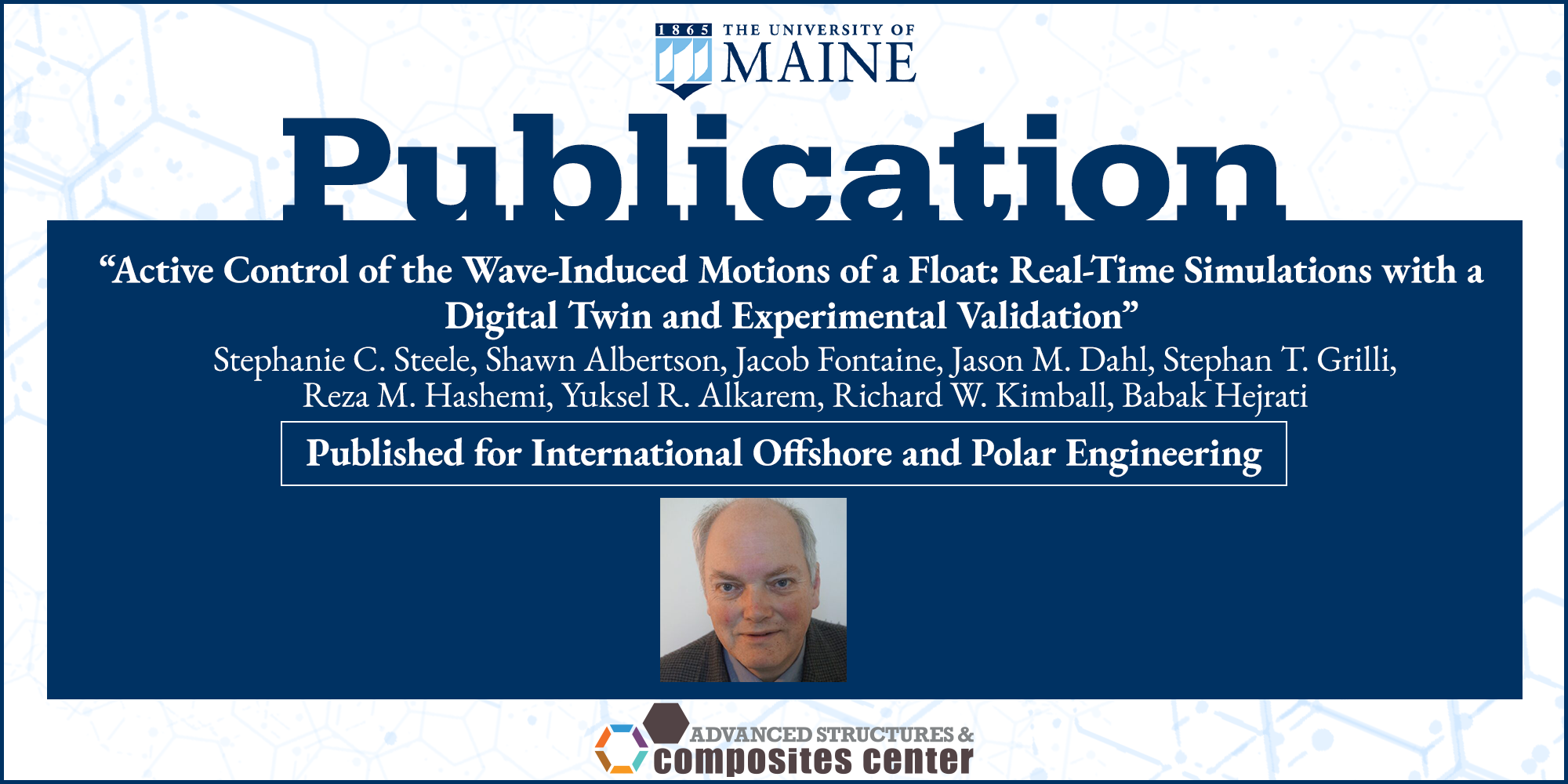
Article by Kimball published for the International Offshore and Polar Engineering Conference
Orono, Maine — An article authored by ASCC researcher Dr. Richard Kimball was published in preparation for the 33rd International Offshore and Polar Engineering Conference. The paper focuses on the development and validation of a control system to counteract effects of wave-induced forces and movements on floating offshore wind turbines. Co-authors include UMaine graduate student Yuksel Alkarem, mechanical engineering professor Babak Hejrati, and researchers from the University of Rhode Island.
For optimal design and operation, it is imperative to minimize wave-induced motions for floating offshore structures like wind turbines. Researchers developed and tested a system that uses real-time simulations of wave-induced motions to assess and counteract them. In URI’s wave tank, the model faced simulated waves in both periodic and irregular spurts to determine its efficacy as opposed to the traditional moving ballast system. The control implemented a Digital Twin model, which consists of a nonlinear model that is used for predicting the motion of the offshore floating structure. This is done by logging incident wave characteristics as well as an extended Kalman filter for characteristics that are not directly measured. Ultimately, the control model acts as a proof of concept demonstration of the real-time algorithm that can be further investigated, refined, and incorporated into floating offshore wind systems.
The results found in the experimental validation will be presented at the 33rd International Ocean and Polar Engineering Conference. The conference will be held in Ottawa, Canada from June 19-23, 2023.
Active Control of the Wave-Induced Motions of a Float: Real-Time Simulations with a Digital Twin and Experimental Validation
Authors: Stephanie C. Steele, Shawn Albertson, Jacob Fontaine, Jason M. Dahl, Stephan T. Grilli, Reza M. Hashemi, Yuksel R. Alkarem, Richard W. Kimball, Babak Hejrati
Abstract
Floating offshore structures, which are subject to wave-induced motions, are used in a wide range of ocean engineering applications, from vessels of various sizes, to oil and gas platforms (TLPs, simply tethered, . . . ), and more recently, floating offshore wind turbine (FOWT) design concepts. To optimize a variety of design and operational factors, it is important to minimize these wave-induced motions, which in some cases may require using semi- or fully-active methods that may use phase-resolved information about incoming waves. In the latter case, a mass or water ballast can be actuated or moved by a pump to counteract effects of the wave-induced forces and moments on the float, on the basis of some control law. Here we present the development and experimental validation of a control system based on real-time simulations of the wave-induced motions of a floating object, with its active control method, using a complete physics-based model, referred to as a digital twin (DT). For demonstration and validation, the system is applied to a barge-like float, for which a 1:19.22 scale model is tested in a laboratory wave tank (30 m long, 3.6 m wide and 1.8 m deep) in our facilities, while being placed transverse to the tank axis, in regular or irregular waves. The float is equipped with a nonlinear model predictive controller based on a mass moving horizontally on a slider in the barge’s beam direction to control its rolling motion, actuated by a linear motor. The controller is actuated based on the DT modeling of float heave and roll including the effect of the moving mass, informed by the assimilation of past float motions and, optionally, using phase-resolved wave data at the float (either measured or predicted based on a separate model) incorporating disturbance previewing in the controller. In the experiments, the complete system is implemented and run in realtime on a desktop computer. Results will be presented and discussed, showing a significant reduction in float motions when the active control method is used. Considerations for using a similar concept to control FOWT motions will be presented as well as the potential for using open source software (OpenFAST) as a real time DT.
Keywords: hydrodynamics modeling; dynamic positioning; control; model predictive control; model test
Contact: Grace Bradley, grace.a.bradley@umaine.edu
